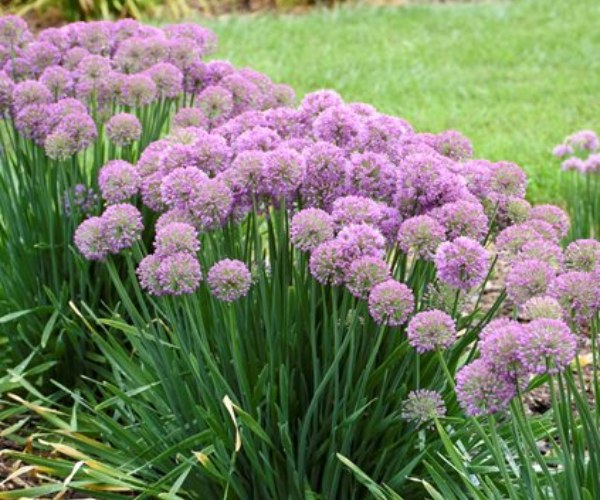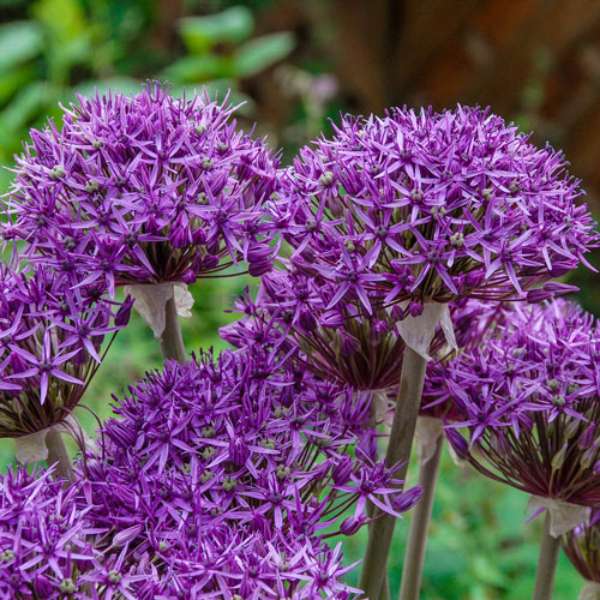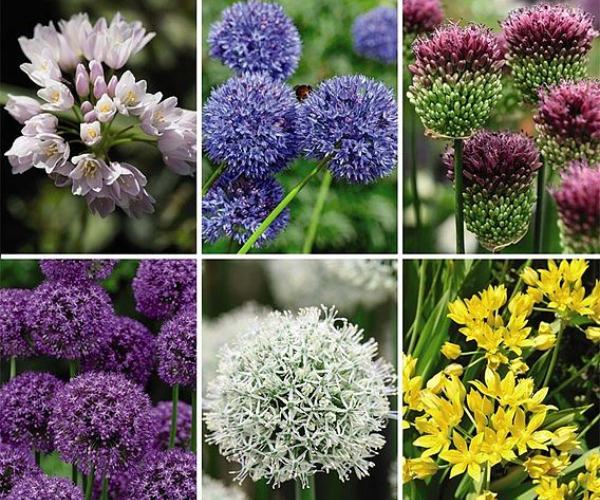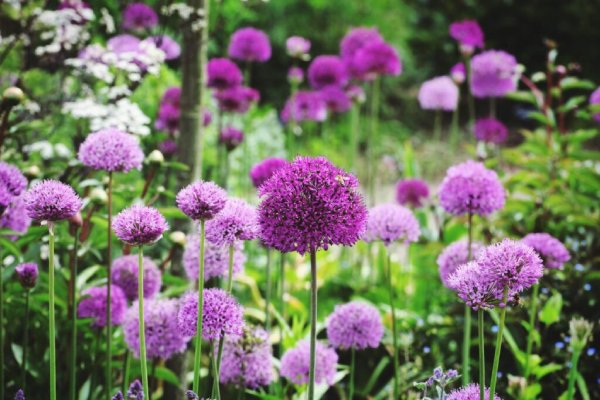Allium bulbs are flowering plants often grown for their ornamental value. They are commonly planted in borders, rock gardens, containers, or even allowed to naturalize in meadows. These perennials belong to the onion family and are also commonly known as ‘Ornamental Onion.’ Allium is popular for its striking globe-shaped flowers which are available in different colors including pink, purple, yellow, white, and green. The flowers form in a spherical or bell-shaped umbel which are made of numerous small, star-shaped blooms. Similarly, its foliage typically grows directly from the base of the plant, and the color of the leaves can range from vivid green to bluish-green.
Well, these blooms make a wonderful visual display when planted in groups that would enhance any garden. Here we will share essential tips for growing and caring for Allium Bulbs.
Plant Descriptions
Plant Type: Perennial, Bulb
Scientific name: Allium
Common name: Ornamental onion
Genus: Allium
Family: Onion
Season: Late spring, Early summer
Native Area: Middle East
Toxicity: Toxic to dogs and cats
When to plant Allium Bulbs?
Allium bulbs should be planted in early to mid-autumn, typically around October. Planting bulbs in October usually have the longest flowering period. While bulbs planted later in the season may bloom for a shorter time. However, the blooms will still be visually appealing as long as the bulbs are planted before the first frost. Since alliums are spring-flowering plants, you can plant them along with daffodils, tulips, and hyacinths. As perennials, alliums will not only provide beautiful bloom in their first year but also continue to bloom year after year if planted in a suitable environment. However, avoid any bulbs that are moldy, soft, or rotten because these will affect all other healthy bulbs around them. Furthermore, if the planting is too late in the season, they may not grow to their fullest. As a result, it may lead to less vibrant growth and flowering.

Growing and Caring Tips for Allium Bulbs
Light
Alliums prefer full sun to partial shade. However since many alliums have brief flowering seasons, they require as much sunlight as possible. Planting them in a sunny area will result in stronger plants with brighter, more colorful blooms.
Soil Preparations
Alliums thrive in well-drained soil with slightly acidic to neutral pH of 5.5 and 6.5. However, avoid placing the bulbs in damp soil, particularly while they are not growing. If the soil stays generally too wet, the bulbs may rot. Similarly, if your soil is thick clay, you can add compost or grit for improved drainage.
Water
Alliums don’t need frequent watering. If it rains regularly, that usually provides enough moisture. Otherwise, water them every three to five days or during extended dry periods. Further, avoid overwatering as that can cause the bulbs to rot.
Temperature and Humidity
Most alliums thrive in USDA hardiness zones 4–10. However, most varieties can resist any kind of temperature because they bloom before the warmest part of summer.
Fertilizer
If you consistently improve your soil, Alliums don’t require much fertilizer. However, when they begin to bloom, you can add a slow-release granular or liquid fertilizer. This helps them regain energy for blooming. You can apply it in early spring when new growth begins.
Pruning
Alliums don’t require much pruning, however, it is important to remove the dead leaves and stems if they die naturally. When the first frost comes, the leaves can become slimy. If you don’t take them off quickly, they might rot and damage the bulb.
Pests and Diseases
Ornamental onions are relatively pest-resistant. Many insects are naturally repelled by their pungent onion fragrance. However, they can be prone to fungal diseases such as downy mildew and rot. Downy mildew causes yellow, brown, or light green blotches on top of the leaves and mold on the underside. This may cause the leaves to wilt and eventually die. This should be avoided by not overwatering or allowing the compost or soil to become too wet.

Does Allium grow from seed or bulb?
Alliums can be grown from both seeds and bulbs. However, if you already have a grown allium plant then growing them from bulbs is much easier and faster compared to seeds. The bulbs will produce offsets so it is easy to propagate by division. In the fall, you should dig up the plant once the flowers are gone and the leaves have died down. Then, carefully separate the bulbs along the visible division lines. Replant a healthy bulb in the original spot, and plant the others in different areas of your garden.
Growing alliums from seeds requires patience as it takes several years for the plants to start blooming. Most of the seeds will sprout within 12 weeks, although the timing can vary depending on the species. To speed up germination, it is best to plant the seeds indoors. Fill trays with gritty compost, plant the seeds, and cover them with a thin layer of grit about 5mm thick. After planting, place the trays outside in a shady area. Alternatively, you can store the seeds in the fridge and plant them in the spring when the temperature is around 13°C (55°F). In regions with mild winters, you can also plant allium seeds in late summer, fall, or early winter. Well, when you grow alliums from seeds, the new plants might not look exactly like the parent plants. This is because hybrids can vary in color and shape.
Varieties of Allium
Allium is a beautiful flowering bulb with hundreds of species. Its blooms are striking and resemble fireworks that enhance spring and summer gardens. Here are some varieties included:
Showy Allium
Showy Allium, whose scientific name is Allium rosenbachianum, is a 4-inch wide globe of purple flowers that blooms early in the late spring season. These flowers are unique and elegant, growing up to 3 feet tall. Each globe features over 50 star-shaped florets adorned with prominent, white statements. Further, Showy grows best in full sun along with well-drained soil. It thrives in USDA hardiness zones 4-10.
Giant Allium
Giant Allium, also known as Allium giganteum, is one of the largest ornamental onions. It is a perennial plant that can grow up to 6 feet tall. This plant produces large globe-shaped clusters of purple flowers alongside grayish-green, strap-shaped leaves. As the plant starts to flower, the leaves begin to die. Similarly, when its leaves and stems are crushed or damaged they start to smell like onions.
Persian Blue Allium
Persian Blue Allium, whose scientific name is Allium aflatunense, is one of the most common species. It produces a four-to-five-inch large, rounded clusters of vivid purple-blue flowers. They have a distinctive onion or garlic smell. It thrives in full sun to partial shade. Similarly, they are drought-tolerant in summer. However, while they are blooming, they will grow even better if they receive much moisture.

Conclusion
In conclusion, Allium bulbs are a delightful addition to any garden, popular for their striking globe-shaped flowers and attractive foliage. These perennial plants, known as Ornamental Onions, come in various colors and create a dramatic visual impact when planted in groups. To help Alliums thrive, plant them in early to mid-autumn. Choose well-drained soil and ensure they get plenty of sunlight. Water them regularly, however, avoid overwatering as that can cause the bulbs to rot. Similarly, make sure the soil is prepared properly and give them some fertilizer for optimal growth. Even though Alliums are easy to care for, they are affected by fungal diseases such as downy mildew and rot. So, inspect the plant regularly. Whether you grow Allium from bulbs or seeds, it will bring lasting beauty and a lively display to your garden.
Also read, A Complete Guide to Growing and Nurturing Mexican Hat Flowers (Prairie Coneflower)
Frequently Asked Questions
1. What are Allium Bulbs?
Allium bulbs are flowering plants often grown for their ornamental value. These perennials belong to the onion family and are also commonly known as ‘Ornamental Onion.’ Allium is popular for its striking globe-shaped flowers and is commonly planted in borders, rock gardens, containers, or even allowed to naturalize in meadows.
2. What type of soil is best for Alliums?
Alliums prefer well-drained soil that is slightly acidic to a neutral pH of 5.5 to 6.5. However, avoid heavy, clayey soil that retains water as it can lead to bulb rot. If your soil is thick clay, you can add compost or grit for improved drainage.
3. Can I grow Alliums in shaded areas?
Alliums prefer full sun but can tolerate partial shade. However, they may not bloom as vigorously in shaded areas compared to full sun.
